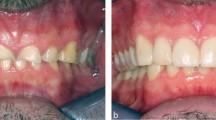Abstract
Providing restorative dental care for patients with tooth wear can, at times, seem complex and demanding. The key to this process lies in a systematic approach that breaks down the component parts. In this chapter, the importance of a comprehensive assessment at the outset will be highlighted. This should include identification of the patient's chief complaint, taking a thorough history, completing the clinical examination, undertaking any special tests and arriving at clinical diagnoses. Together, this information will influence the treatment planning process, identify appropriate treatment concepts and options available and the individual stages that may be involved. The process should be both holistic and thorough to enable the patient and clinician to build a clear pathway and vision. In parallel, and with patient input throughout, it is essential to manage patient expectations as best as possible whilst remaining pragmatic and honest about treatment outcomes, longevity of restorations and the risks of failure.
Key points
-
Outlines a comprehensive assessment for patients with tooth wear.
-
Describes the treatment planning process as being both holistic and thorough to enable a clear pathway and vision.
-
Details how diagnoses can be multiple and may require irreversible investigative processes.
This is a preview of subscription content, access via your institution
Access options
Subscribe to this journal
Receive 24 print issues and online access
$259.00 per year
only $10.79 per issue
Buy this article
- Purchase on Springer Link
- Instant access to full article PDF
Prices may be subject to local taxes which are calculated during checkout










Similar content being viewed by others
References
Loomans B, Opdam N, Attin T et al. Severe tooth wear: European consensus statement and management guidelines. J Adhes Dent 2017; 19: 111-119.
Garcia B G, Ferrer A D, Jimenez N D, Granados F J A. Bilateral parotid sialadenosis associated with long-standing Bulimia: a case report and literature review. J Maxillofac Oral Surg 2018; 17: 117-121.
Rees J, Thomas M, Naik P. A prospective study of the prevalence of periapical pathology in severely worn teeth. Dent Update 2011; 38: 24-26, 28-29.
Hoag E P, Dwyer TG. A comparative evaluation of three post and core techniques. J Prosthet Dent 1982; 47: 177-181.
Magne P, Spreafico R C. Deep margin elevation: a paradigm shift. Am J Esthet Dent 2012; 2: 86-96.
Turner K A, Missirlian D M. Restoration of the extremely worn dentition. J Prothet Dent 1984; 52: 467-474.
Abduo J. Safety of increasing vertical dimension of occlusion: a systematic review. Quintessence Int 2012; 43: 369-380.
Moreno-Hay I, Okeson J P. Does altering the occlusal vertical dimension produce temporomandibular disorders? A literature review. J Oral Rehab 2015; 42: 875-882.
Dahl B L, Krogstad O, Karlsen K. An alternative treatment in cases with advanced localised attrition. J Oral Rehab 1975; 2: 209-214.
Gulamali A B, Hemmings K W, Tredwin C J, Petrie A. Survival analysis of composite Dahl restorations provided to manage localised anterior tooth wear (ten-year follow-up). Br Dent J 2011; 211: E9.
Elderton R J. Preventative (evidence-based) approach to quality general dental care. Med Princ Pract 2003; 12(Suppl 1): 12-21.
Vailati F, Belser U C. Classification and treatment of the anterior maxillary dentition affected by dental erosion: the ACE classification. Int J Periodontics Restorative Dent 2010; 30: 559-571.
Acknowledgements
The BDJ Editorial Team would like to thank the author of this chapter for granting us permission to republish their chapter within our journal. This chapter was first originally published in Andrew Eder and Maurice Faigenblum (eds), Tooth Wear, BDJ Clinician's Guides, https://doi.org/10.1007/978-3-030-86110-0_10 © Springer Nature Switzerland AG 2022.
Author information
Authors and Affiliations
Corresponding author
Rights and permissions
About this article
Cite this article
Stone, R. Treatment planning for patients with tooth wear. Br Dent J 235, 190–196 (2023). https://doi.org/10.1038/s41415-023-6116-y
Published:
Issue Date:
DOI: https://doi.org/10.1038/s41415-023-6116-y



